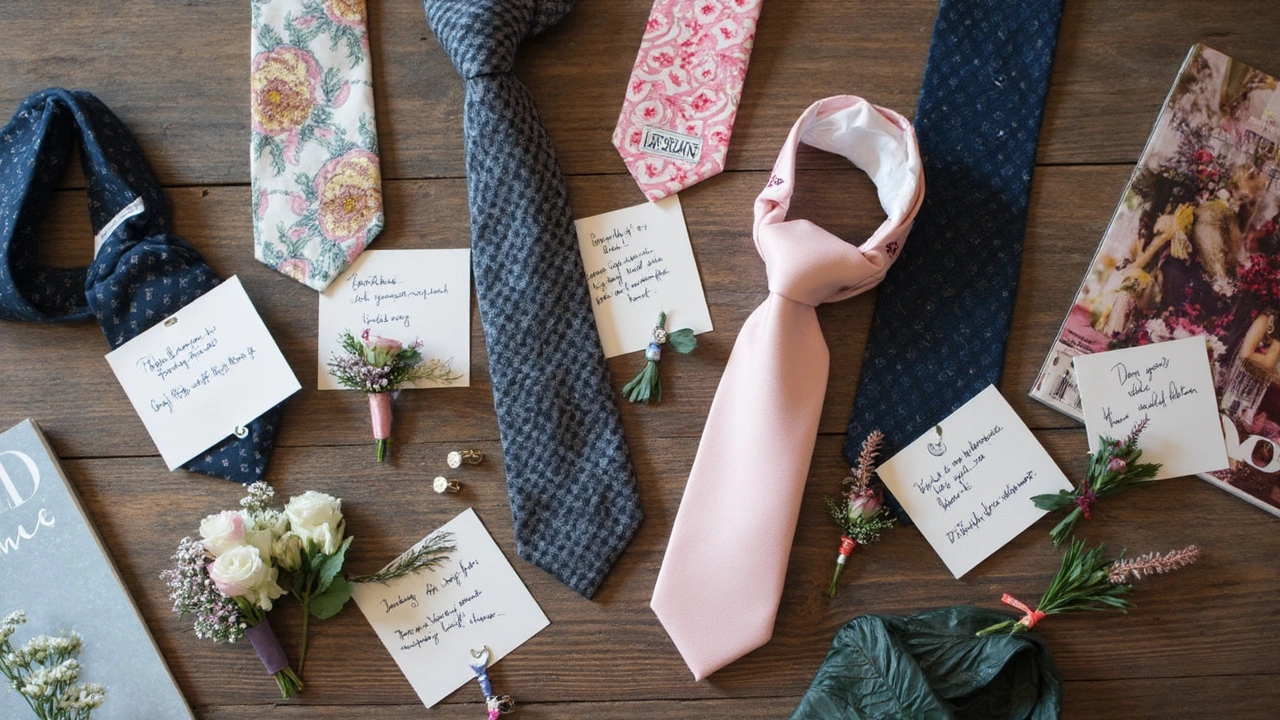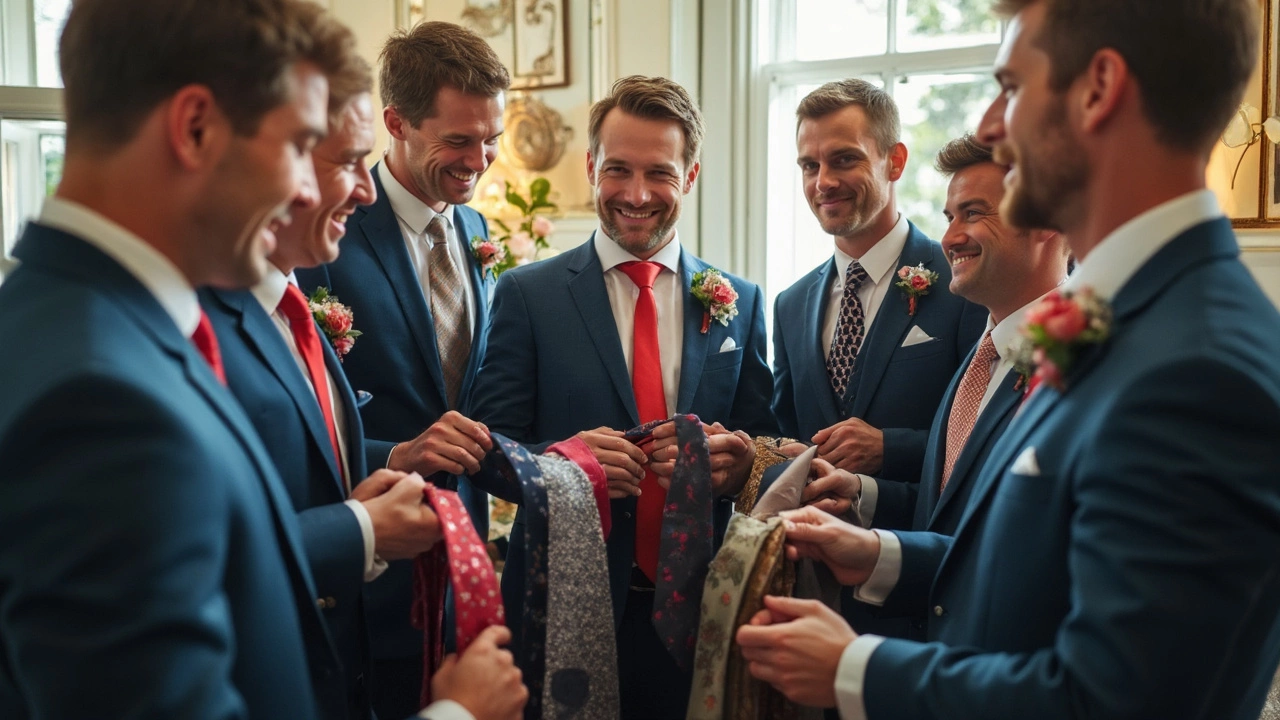Shopping for wedding ties sounds simple, right? Until you realize no one’s exactly sure who should pay for them. Some guys just assume it’s on the groom, others say each groomsman should handle his own.
If you’re trying to map out your wedding budget and not sure what’s normal, you’re not alone. In most weddings, there’s no official rulebook. A lot depends on budget, style choices, and the vibe you want for your group. If you’ve got a tux rental place pushing matching ties on you, pay attention—sometimes it’s easier to buy all the ties yourself so you know everyone matches, but it can add up fast.
Talking money with friends can feel awkward, but being upfront saves headaches later. If you’re thinking about paying for everyone’s ties, look at your other costs first. But if the group is okay grabbing their own, just make sure you share the exact color and style so nobody shows up with something wild—unless that’s your thing.
- Who Usually Buys the Ties?
- Traditional Versus Modern Expectations
- How to Pick the Right Ties
- Coordinating With the Wedding Theme
- Budget Breakdown: Saving or Splurging
- Real Stories: What Guys Actually Do
Who Usually Buys the Ties?
If you ask 10 couples, you’ll probably get 10 different answers. The most common setup? The groom or the couple buys the ties for all the groomsmen. According to The Knot’s 2024 Wedding Attire Study, around 58% of grooms say they cover this cost, especially if they want everyone to wear the exact same color or pattern.
The main reason is control—you know everyone will match, and no one shows up in a polka dot when you wanted plain navy. Plus, it’s a nice little gesture and makes your guys feel included. It’s kind of like giving them a welcome-to-the-team gift.
“If you want your groomsmen to wear something specific and uniform, you’re expected to supply it or pay for it,” says Jenna Miller, a lead editor at Here Comes the Guide.
There are plenty of weddings where each groomsman pays for their own tie. This usually happens when the tie isn’t custom or super unique—maybe just a simple color match. But if you’re picking something unusual, it’s more common (and polite) for the groom to handle the cost.
- If the ties are custom or hard to find, the groom usually pays.
- If everyone is picking up a basic tie off Amazon, splitting the cost or asking groomsmen to buy their own is pretty normal.
- If you’re buying a full set (suit, shirt, tie), bundling it all together makes things simple.
One thing nobody likes? Last-minute confusion. Decide early, let everyone know, and try to keep things as simple as possible. For a quick look at what’s most common, here’s how the numbers stack up:
| Who Pays | Percent of Weddings |
|---|---|
| Groom (or couple) | 58% |
| Groomsmen | 39% |
| Other (shared or family/gift) | 3% |
No big rules, just a few clear patterns. If you want your groom squad to look put together, sort out the tie-buying plan early and keep everyone in the loop.
Traditional Versus Modern Expectations
If you ask your parents or grandparents about who buys the ties for the wedding, they’ll likely say it’s all on the groomsmen. Traditionally, each groomsman would pay for his own outfit, including tie, shirt, and sometimes even shoes. The idea was simple—if you’re standing up with the groom, you need to look the part, and covering your own gear was just part of the deal.
That old-school approach still works for some crowds, especially in really formal weddings or when folks are renting their suits from the same shop. In fact, many rental places bundle the tie, so each guy can pick up his full look in one stop. This method keeps things organized but can get pricey depending on the shop and tie choice.
But these days, things are way more flexible. Modern wedding parties switch it up based on budget, style, and how close the group is. You’ll see a lot of grooms taking the lead on buying the ties for everyone, especially when they want a specific color or pattern that matches the wedding scheme. It guarantees everyone’s photo-ready and takes the pressure off friends who might be tight on cash.
Group chat polls, Venmo requests, or even a party Amazon order happen far more now than a decade ago. If you want an exact look, paying upfront and handing out the ties before the big day just makes life easier. But if your friends like a little creativity or already own something close, giving them the details and letting them choose works, too.
- Traditional rule: Groomsmen buy their own ties and suits.
- Modern trend: The groom buys the ties for a coordinated, polished look.
- Mix-and-match: Some groups choose a color family and everyone finds their own version.
Whichever way you go, just set clear expectations at the start. That avoids any awkward “Who’s covering this?” conversations as the day gets closer. And remember, the real goal is having everyone look good together—in photos and in the moment. For anyone searching "does the groom buy the ties," it's all about what feels right for your crew.
How to Pick the Right Ties
Choosing ties for your wedding isn’t just about picking any random color hanging on a rack. There’s a method, and if you’re not careful, you could end up with a pile of mismatched looks in your wedding photos. Start by thinking about your suit color, the season, and how formal you want things to feel. For example, blues and greys work for just about any wedding, while bolder colors and prints can make things pop for spring and summer.
The number one rule: keep it simple if you’re unsure. Solid colors or subtle patterns are safe, especially if your suits are classic. For those who want to add a little flair (maybe a quirky print), make sure the groomsmen are comfortable with it. Just one wild tie in a group photo can throw off the whole look. Take fabric seriously too—silk is the traditional pick for formal weddings, but cotton or linen works great for outdoor, casual feels.
If you want your group to coordinate, give super clear instructions. Send pictures or actual links of the exact tie. When left to guess, someone might show up with a different shade or a totally different style. You’d be surprised how many weddings get tripped up by different versions of “navy blue.” Stores also run out fast during peak season, so order with time to spare.
- Pick your suit color first, then match the tie. Don’t do it the other way around, or you’re just making life harder.
- Consider textures—matte finishes are less formal, shiny ones feel more dressed up.
- If your wedding palette is complicated (say, four or five colors), anchor your look with a neutral tie. Let pocket squares or boutonnieres handle the rest.
- When in doubt, stick with timeless options: navy, deep burgundy, or charcoal. These never miss.
Here’s a quick look at which fabrics and colors tend to work for different weddings:
| Season | Recommended Tie Fabric | Popular Colors |
|---|---|---|
| Winter | Silk, Wool Blend | Emerald, Burgundy, Charcoal |
| Spring | Cotton, Linen | Soft Blues, Sage, Lilac |
| Summer | Linen, Cotton | Navy, Peach, Pastels |
| Fall | Silk, Wool Blend | Rust, Deep Green, Gold |
The groom really sets the tone here, so don’t be afraid to show your style—but you want the group to look sharp together. Grab a few samples, snap some test photos, and pick what actually feels good. That way, nobody looks back at the pictures wishing they’d spoken up about those neon orange neckties.

Coordinating With the Wedding Theme
Ties might seem like a tiny detail, but they can totally make or break your whole wedding look. It’s not just about picking a color you like—your ties should actually vibe with the overall wedding theme, whether that’s rustic, classic, or full-blown retro party. If you’re running with a planned-out color palette, start there. A tie that pops against a navy suit or gently matches your partner’s dress details? That’s the good stuff.
You don’t have to guess which colors go together. There are loads of color palette tools online. And don’t forget about season and venue. Outdoor summer weddings lean into lighter fabrics and pastel colors; fall barn parties scream for deeper shades and maybe even wool or knit ties. If you’re not sure, just ask the venue or your wedding planner what couples usually pick—most have seen enough to spot a miss-match a mile away.
"Ties are usually the easiest way to tie your wedding’s whole color story together. Even small details like the pattern can make a big difference in photos." — Daniel Post Senning, etiquette expert at The Emily Post Institute
Don’t ignore patterns and textures. Stripes, polka dots, floral, or even a sleek satin bowtie—all these small moves should match the *vibe*. Say you’re doing a black-tie evening; solid black or dark silk ties are practically a must. For a rustic vibe, maybe go with earth tones or linen. Mixing textures (like pairing wool ties with tweed suits) can give things a cool, layered look without getting too fussy.
Here’s a quick breakdown of colors and styles that go with popular themes:
| Wedding Theme | Tie Colors | Material/Style |
|---|---|---|
| Classic Black-Tie | Black, navy, deep jewel tones | Silk, satin, bowties |
| Rustic Barn | Earth tones, sage, burgundy | Wool, linen, skinny ties |
| Modern Minimalist | Muted neutrals, grey, blush | Slim, solid, matte finish |
| Beach/Outdoor | Pastels, light blue, sand | Linen, cotton, floral prints |
If you want the groom and groomsmen to really stand out, some couples pick slightly different ties for each but keep them within the same color family. If you do this, just make sure to check how it looks in group photos—sometimes slight differences look great in person but read oddly on camera.
One big tip: order extra ties. Yep, stuff happens. Someone will forget theirs, spill coffee, or a last-minute groomsman might pop up. Having backups means you’re not scrambling on the wedding morning. Trust me, it’s worth the $20.
Budget Breakdown: Saving or Splurging
The cost of ties can sneak up on you when you’re adding up all your wedding suit stuff. Seriously, those little strips of fabric aren’t always as cheap as they look in the store window. You’re probably asking: Do I splash out so everyone’s matching, or do I save cash and let the guys handle it?
Let’s talk numbers. The average price for a basic, decent tie is about $15-$30. Designer or custom ties? That jumps to $60, $100, or even more if you want something special. Multiply that by however many people are in your crew, and it piles up fast. Here’s a quick comparison:
| Type of Tie | Average Cost (USD) |
|---|---|
| Retail/Budget Tie | $15–$30 |
| Mid-Range (Department Store) | $40–$75 |
| Designer/Custom | $90–$150+ |
If you ask most wedding planners, they’ll say, “Pick one person to pay for all the ties and add it to the main wedding budget if matching is non-negotiable.” According to a recent survey by The Knot, 67% of grooms end up buying ties for their group because they want everyone to have the exact same look—but there’s no shame in asking the guys to chip in if funds are tight.
"Consistency in groomsmen attire really pulls together wedding photos, but there’s nothing wrong with budgeting for what feels comfortable for your group." — Sarah Rossi, certified wedding planner, quoted in Brides magazine
Here’s how you can save without making it awkward:
- Buy in bulk or scout group discounts—plenty of online retailers offer deals for wedding parties.
- If you’re going for a specific color, sometimes fabric stores or online marketplaces have solid options for less than $20 each.
- Not stuck on ties? Look at bow ties, pocket squares, or even no tie at all, which is picking up steam with less traditional weddings.
The bottom line: decide what matters most—picture-perfect matches or keeping the group happy (and wallet-friendly). Share the plan early so nobody’s surprised, and remember, your day isn’t about the price tag on your necktie.
Real Stories: What Guys Actually Do
Let’s skip the guesses—here’s what actually goes down when it’s time to pick up wedding ties. Ask around, and you’ll find every group seems to handle it their own way, but a few real-life patterns pop up again and again.
The most common setup these days? The groom picks out ties for everyone and foots the bill. Especially if you want your whole crew in the exact color or pattern, it just takes the stress off everyone else. In a survey run by The Knot in 2024, around 57% of grooms said they just bought ties for their groomsmen to make life easier.
But not every wedding budget is the same, so sometimes grooms ask their guys to cover their own neckwear. This usually works best if ties are affordable—think under $30. Clear instructions are a must, though. If you leave guys to their own devices without sharing links or swatches, you might wind up with five versions of "navy blue." In a Reddit poll last year, about 36% of groomsmen said they paid for their own ties, but only if the costs were fair and expectations set early.
| Approach | % of Weddings (Surveyed, 2024) |
|---|---|
| Groom Buys Ties | 57% |
| Groomsmen Buy Their Own | 36% |
| Cost Split Evenly | 7% |
There are outlier stories, too. Some groups go for wild mismatched ties as part of the look (every guy picks his favorite). A few really crafty guys even made their own, which is definitely not the norm but makes for great stories. The key is communication—every story that ended well had the group on the same page early.
Quick tip: If you’re buying for everyone, order a few spares. Someone always forgets or loses one. If you’re splitting the cost or letting guys choose, give a clear deadline and offer a backup for anyone who forgets. Simple fixes save stress.

